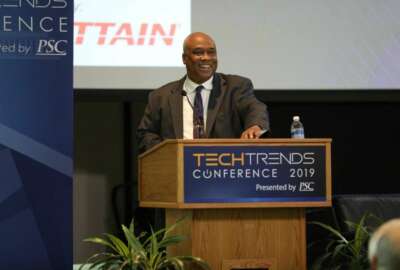

Michael Wooten, the administrator of the Office of Federal Procurement Policy, said under the frictionless acquisition cross-agency priority goal under the...
Best listening experience is on Chrome, Firefox or Safari. Subscribe to Federal Drive’s daily audio interviews on Apple Podcasts or PodcastOne.
The Office of Federal Procurement Policy’s new cross-agency priority goal isn’t about changing the acquisition rules or processes.
Instead, the goal of frictionless acquisition is about how contracting officers, program managers, industry and so many others view what it takes to buy a product or service.
Michael Wooten, the administrator of the Office of Federal Procurement Policy, said frictionless acquisition is part of his plan to reduce complexity through leadership.
“We are really focused on reducing the time between when a person conjures up a need and when they get what they want,” Wooten said in an exclusive interview with Federal News Network. “We think the opportunities for friction are significant because of the scale and scope of the federal acquisition system, the complexity of our requirements can be mind boggling when you look at some of the systems under development, whether it’s the Defense or Energy departments or whomever, and then the myriad of systems and processes that support this.”
As a result of this friction, Wooten said agencies, contractors and taxpayers are feeling the brunt through increased costs, increased time to market and decreased value.
“We believe these friction points accumulate over the lifecycle of the acquisition,” he said. “We are concentrating on reducing the barriers to entry. As we started thinking about the large sector of stakeholders, not just the agency for which we buy goods and services, but the private sector offerors, we thought about reducing the friction there. It’s a concept that has expanded and is now a foundational philosophy.”
Wooten has talked about this concept of reducing friction in the acquisition process since his nomination hearing. So making it a cross-agency goal under the President’s Management Agenda gives the idea more than just words, but a series of goals and milestones over the next 18 months.

Along with Wooten, Soraya Correa, the Department of Homeland Security chief procurement officer, and Barry Berkowitz, the Commerce Department’s senior procurement executive, are leading this three-pronged effort that focuses on promoting continuous process improvements, getting more value out of acquisition data and using technology to improve customer service.
“We need to look at frictionless acquisition as a mindset that helps us do just-in-time delivery for commercial items when just-in-time is possible, and manage customer expectations when just-in-time is not possible,” Wooten said. “The notion of frictionless acquisition has bloomed and expanded to reducing friction among all stakeholder interactions.”
One of the goals to reduce friction is the expansion of the service acquisition workshop (SAW) to improve how agencies develop requirement documents. DoD and the General Services Administration have used the SAW approach on selected acquisitions over the last few years. Under the CAP goal, the administration wants three agencies to conduct pilots using facilitated requirements development workshops and three agencies to have trained facilitators.
Another milestone is the expanded use of robotics process automation and artificial intelligence. Under the CAP goal, the administration wants 15 agencies to test the use of RPA, AI, and other emerging technologies “to save tens of millions of dollars and redirect hundreds of thousands of acquisition work hours away from lower value acquisition activities across the acquisition lifecycle, from completion of documentation requirements, including for purchase card holders, to support for contractor responsibility determinations, contract closeout and data validation.”
“We know process automation tools can help us rapidly complete routine processes. These are processes we can flow chart in a decision diamond. A lot of the work processes in procurement follow that type of pattern,” Wooten said. “There is a level of comfort with that. If I can follow the program decisions, so can process automation tools, and they can do it faster, cheaper and more accurately than people can. That frees us up to make the judgments that people can do and process automation tools can’t do. That’s where our highly educated workforce needs to be.”
Underlying these efforts is the acquisition data. Wooten said by August, OFPP wants to test out ways to bring in new data sources and make that information more valuable through data visualization. The CAP goal leaders will “issue [an] AcqCelerator challenge for data mashing, cleansing and visualization” in the next month.
Finally, Wooten said the CAP goal addresses ongoing workforce challenges. OFPP will issue a draft blueprint for the workforce by 2025.
“It’s about culture and leadership. We are not putting a lot of emphasis on changing rules, but change the way people operate within the rules,” he said. “We are not doing anything nefarious. We think the compliance checks that are well established and need to continue. But there is a faster, better way to do it — and frankly, we can do it more accurately.”
The CAP goal leaders want to get this workforce 2025 draft blueprint done by October.
“This requires me to do the ‘vision’ thing to help people see and understand what we are talking about,” he said. “The process automation tools ought to take a lot of those mundane tasks off the workers’ plate. For the more complex or non-program decisions that our professionals will be called on to make, artificial intelligence can assist them by giving them suggestions and with data analytics to harvest information.”
The workforce blueprint also includes a new approach to training where it’s not just all about going to classes to check certain boxes and satisfy certification requirements. Wooten said he wants the workforce to gain competences and hard skills to return value to the agency, and that may include near learning mechanisms.
This concept of frictionless acquisition has been at the top of many procurement leaders’ minds since the start of the coronavirus pandemic. Agencies have had to use all the agility and flexibility contained in the FAR to meet the needs of their employees as teleworking surged.
Wooten said the pandemic, like many emergencies, has been a catalyst for innovation.
He said OFPP’s July 14 guidance highlights several innovation and flexibilities for agencies and vendors alike.
“We think that being able to come up with more rapid approaches just made sense, particularly in the COVID environment where the acquisition workforce needs to be doing the most important thing to respond to the pandemic,” Wooten said.
Wooten said the pandemic emergency showed the rules aren’t the problem most of the time.
“There are culture differences and there are differences in the way agencies handle friction. So one of the things we need to do in trying to promote a frictionless acquisition system is to do more cross-agency information sharing, more leadership training and more discussions about best practices,” he said. “We also think we can add to the framework that already has been in place that has significantly reduced friction. For example, we have reduced friction for common goods and services through category management. We have saved tens of billions of dollars in the last three years and transformed how we buy over $350 billion a year. Category management is building a future framework for data analytics. Instead of us being bogged down in information friction and being slow to think and act, we will be able to harvest data and leverage it to make decisions faster.”
Copyright © 2025 Federal News Network. All rights reserved. This website is not intended for users located within the European Economic Area.
Jason Miller is executive editor of Federal News Network and directs news coverage on the people, policy and programs of the federal government.
Follow @jmillerWFED


